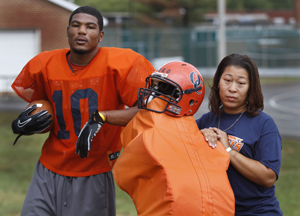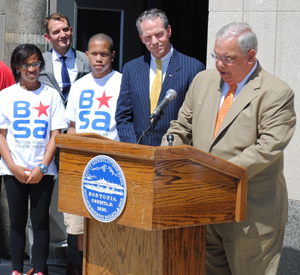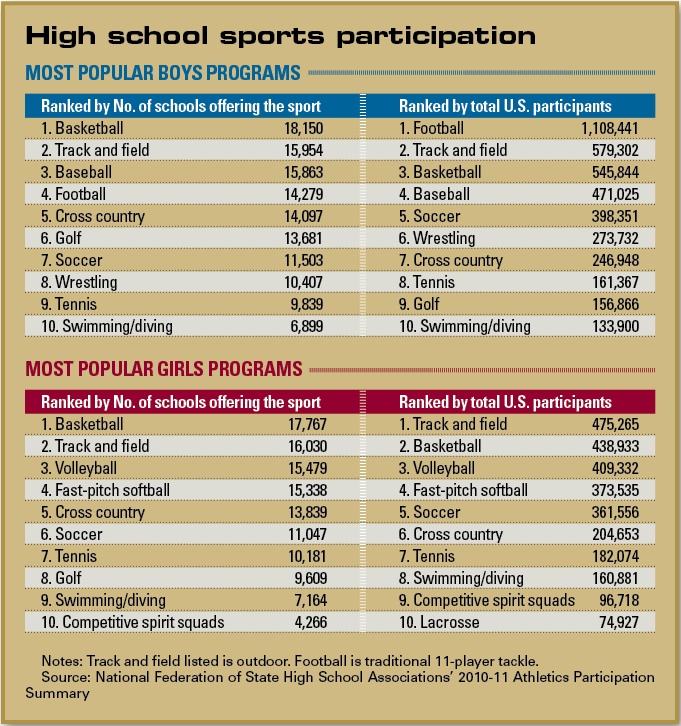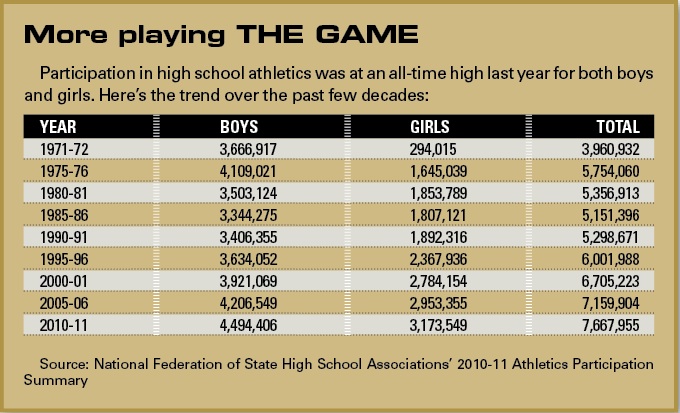Each of the past two years, it took last-minute $250,000 donations by the likes of Michael Jordan and NASCAR team owner Rick Hendrick to save middle school sports in Charlotte from the chopping block.
Last summer, Jordan and his NBA franchise, the Charlotte Bobcats, came to the rescue as the local school system battled budget cuts, pledging $250,000 for the 2010-11 year. Then, last month, Hendrick, one of the nation’s most successful auto dealers and owner of race cars driven by Jimmie Johnson and Dale Earnhardt Jr., picked up where Jordan left off, signing a sponsorship that promotes his HendrickCars.com website.
Hendrick views the donation as more of a feel-good campaign than a hard sell. Growing up in rural Virginia, he played several sports in high school and credits his coach with instilling discipline and respect — and keeping him motivated to graduate.
“I know what it meant to me,” Hendrick said. Keeping middle school athletics available in Charlotte “will help kids.”
 |
AP IMAGES
School systems are doing everything from holding raffles to seeking equipment donations to make up for budget cuts. That’s the case at Orange County High School in Orange, Va., where Alyssa and Amir Waller pose on the football practice field last year. |
They need it. As the example above illustrates, the trickle-down effects of devastating cuts in high school sports are being felt at lower levels, too. And, for high school programs and districts across the country, what worsened during the recession is growing grimmer during its sluggish aftermath.
Districts are scrambling to maintain programs while trimming costs and adding ancillary revenue wherever possible. Participation fees, corporate sponsorships, more ambitious booster clubs and other campaigns have surged in recent years as the reality of youth sports’ dire funding straits settles in.
After surveying the landscape of late, experts remain pessimistic of a recovery any time soon.
“It’s only gotten worse,” said Brian Greenwood, an assistant professor at Cal Poly San Luis Obispo who specializes in parks, recreation and youth sports. “With the stimulus money, a lot of school systems were able to piece things together. School systems are in worse shape now than they were two years ago.”
Reductions in spending on youth sports in public schools totaled $3.5 billion the past two years, according to New York-based Up2Us, a nonprofit dedicated to increasing participation. The ripple effects of such cuts will be felt for years to come, coaches, administrators and other experts say.
In an informal sampling of scattered schools and districts, several recurring themes emerged. Citing numerous studies, experts point to the costs of not funding sports programs: higher dropout rates, more truancy and gang activity, childhood obesity and higher rates of drug and alcohol abuse among children who are sedentary.
A sampling of responses from across the country shows similar problems and a variety of stopgap solutions. Among them:
■ At the Boston Scholar Athlete program, a public-private partnership aimed at using sports to improve academics,
 |
BOSTON SCHOLAR ATHLETE
Boston Mayor Thomas Menino helps the Boston Scholar Athlete program kick off the 2011-12 academic year. |
college teams and corporations are among those trying to fill in some of the budget holes. Last year, New Balance donated 1,000 pairs of running shoes. Harvard’s football equipment contract with Nike provides new cleats each season, freeing up the old shoes for use by local high schoolers. And when Northeastern University eliminated football in 2009, the school gave Boston Scholar Athlete all of its helmets, shoulder pads and other equipment.
■ In northeastern Ohio, schools such as Lake High in Uniontown are putting greater emphasis on ancillary revenue from local and regional sponsors. Bruce Brown, the school’s athletic director, said the board of education still pays for transportation ($100,000 annually) and coaching stipends ($150,000 to $200,000), but he has built sponsor revenue of $75,000 to $90,000 per year, money used for physical improvements including a new press box at the football stadium, turf and a roof for the batting cage. “We’ve really worked hard at developing strong partnerships with businesses,” Brown said. “That’s where the AD’s position has changed” beyond scheduling and making sure buses show up on time, he said. While Lake High has avoided participation fees, 44 percent of the state’s 1,604 public high schools and middle schools did use pay-to-play in 2010, said Ohio High School Athletic Association spokesman Tim Stried. He estimates the number now exceeds 50 percent.
■ In California, where pay-to-play is illegal, many school districts have reduced or eliminated junior varsity and freshman teams while also pushing for more booster donations and sponsorship. Some schools and districts are so strapped for money they ask students to meet at the game sites to cut costs. “It’s scary,” said Marie Ishida, executive director of the California Interscholastic Federation. “There are all kinds of liability issues.”
■ At the Mesquite Independent School District in Texas, a Dallas suburb, the five high schools and eight middle schools have 6,000 kids playing in sports programs. Over the next two years, the district faces a combined $7 million in cuts. Steve Bragg, the district athletic director, said participation fees have been avoided through a combination of cost savings and sponsorships. The district has two football stadiums and rotates the five high schools’ schedules to use those venues. Scoreboard ad revenue at the stadiums generates $50,000 annually. In recent years, other savings have been realized by reducing the number of drug tests for student athletes (cutting $50,000 annually), ending traditional reimbursements to booster clubs for banquets ($38,000) and limiting the number of tournaments in which junior varsity and freshman teams play.
A litany of cuts has increased the prevalence of participation fees, the so-called pay-to-play model aimed at shoring up strained budgets. About 40 percent of schools now charge fees to play, said Paul Caccamo, Up2Us executive director.
Greenwood, the Cal Poly professor, compares the pay-to-play trend in youth and high school sports with the proliferation of fees at America’s national parks.
Students in his classes react with surprise when Greenwood tells them about Yellowstone and other national parks not requiring fees in the past.
“They were meant to be free, but somewhere along the way we didn’t value the national parks to where we were willing to either increase our taxes or have the political will to get the money,” he said. “We said, ‘Sure, I’ll pay.’ People who can afford it don’t think twice. Then we start to do the research and we say, ‘Why are marginalized populations not visiting our parks?’ Now in youth sports, we’re seeing it go down the same path.”
One piece of good news for schools and districts: Corporate interest and spending are on the rise. With 7.7 million participants in high school sports, or 55.5 percent of students, and more than 300 million spectators for football and boys and girls basketball alone, it’s easy to see why Nike, Under Armour, McDonald’s, Wendy’s and Gatorade, among others, have entered prep sports.
“We view high school athletics from a corporate standpoint as an opportunity right now,” said Tyson Webber, vice president of client services at GMR Marketing.
Intense interest in recruiting and more media exposure for young athletes have increased the appetite for prep sports. At the same time, challenges include a fragmented audience and a limited range of potential advertisers because of restrictions on what can be advertised to an audience that includes a large segment under 18 years of age.
Erik Spanberg writes for the Charlotte Business Journal, an affiliated publication.








